This extracted piece records an important contemporary description of Miniature Rifles in their many forms.
It has to be said that Henry Sharp perhaps shows something akin to favouritism towards the Westley Richards company's products but, nonetheless, most of the information you might reasonably expect is there. His opinion of the .22 rimfire cartridge may well have had some limited justification over a hundred years ago, but Sharp's prescience of that cartridge's hugely successful future was somewhat short of the mark, economics notwithstanding.
Henry Sharp lived in the village of Friskney in Lincolnshire, which is today one of the largest villages in the Country. He wrote much on field and fowl, and the associated firearms. His books included "The Gun", "Afield and Afloat" and "Practical Wildfowling".
The chapter is taken from
MODERN SPORTING GUNS
By HENRY SHARP
1906
CHAPTER XIII
MINIATURE RIFLES FOR MATCH, TARGET, AND SPORTING PURPOSES
Although for many years miniature rifles of various bores have been used for different purposes in this country, their place in the sportsman's armoury has been neither important nor large. Hitherto, our conception of this type of weapon has been confined to the rook and rabbit-rifle, and during the twenty years that I have observed this question, a considerable number of foreign saloon-guns, principally from Belgium, and similar weapons, mostly in .22-bore, made in America and popularized by the Winchester Company, the Marlin Company, and others, have found their way into the good graces of not a few sportsmen.
The ordinary rook and rabbit-rifles, the Belgian saloon-gun, and the American .22, are too well-known for me to refer to further. In order to give an accurate and detailed account of each variety of miniature rifle embraced in those enumerated, one could fill a respectable volume without, perhaps, rendering much useful service to the reader. However, it may be worth while to place on record the principal types of weapons in this category, giving their size, load, and range, as also their system of breech-action. Rook-rifles as used in this country may be said to be chiefly represented by the following bores—
.297/.230 short, 3 grs. black powder, 37 grs. bullet. Velocity, 800 feet per second.
.297[230 long, 5 grs. black powder, 37 grs. bullet. Velocity, 1220 feet per second.
.250, 7 grs. black powder, 56 grs. bullet. Velocity, 1100 feet per second.
.295, sometimes called .300, 10 grs. black powder, 80 grs. bullet. Velocity, 1100 feet per second.
.360, No. 5, 14 grs. black powder, 134 grs. bullet. Velocity, 1000 feet per second.
These cartridges are also loaded with Cordite and Axite powders, which give an increase of 50 to 100 feet in velocity. They are made as follows —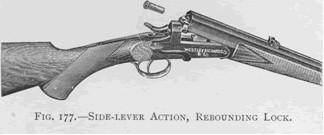
With side-lever action, and external hammer, weight 5½ lb.
With top-lever action, and external hammer, weight 5½ lb.
With top-lever action, hammerless barrel-cocking principle, weight 5½ lb.
With under-lever sliding-block action, weight 5 lb. 12 oz.
With Martini action, weight 5 lb. 12 oz.
The old .380- and .360-bores have gone out of use as being too powerful, and not sufficiently accurate.
The .22-bore I have not mentioned in this connection, as it is too much of a toy to merit serious attention, although it has found favour among certain people principally on account of the cheap price, both of the weapon and its ammunition, which are mainly American. These weapons, doubtless, would be made by British firms, but for the fact that it would pay no manufacturer to lay down costly machinery and tools for the production of the comparatively small number bought in this country. Such trade could alone be rendered profitable with the aid of those other markets which are now closed to our gunmakers by heavy tariffs.
It is, however, inconsistent with the requirements of the sport to adopt the .22-bore for rabbit shooting. The .250-bore is occasionally used with success, but more often than not it is found to be of insufficient power to be thoroughly reliable for this kind of shooting. The .250-bore rifle with bullet made on the Minex principle would doubtless prove effective.
For all-round efficiency .300-bore is now generally recommended, but the adoption of this calibre is more or less of a compromise which has taken into careful account safety, this rather erring in the direction of modified ranging power. Even with this bore, with its present power, however, unless there is sufficient background of clear country beyond, errors of aiming may result in disaster to some wayfarer or farm-labourer. in the fields situated some few hundred yards away from the shooting-grounds. But for this fact, larger and more powerful cartridges and bores of barrels would have been adopted even for the bagging of such small game as rabbits. I think I shall not be far wrong when I say that the .300-bore is the best all-round miniature rifle for rook and rabbit shooting.
The introduction of nitro powder, as in the case of other weapons, has considerably increased the usefulness of miniature rifles. And, moreover, since the late Lord Salisbury, in a memorable speech, pointed out the necessity of all male adults becoming proficient rifle shots, a new interest in miniature rifles has been created, and a great stimulus given to their manufacture and development. Further, this has led to a greater consumption of the foreign-made small calibre weapons to which I have alluded, which has mainly resulted in increasing the foreigners' trade. But, as opposed to this, it has afforded some compensation in the introduction of two or three new weapons, the sole product of English manufacture. These have not only brought fresh competition into miniature rifle manufacture, but have changed the conditions of miniature rifle shooting, and lifted it out of the drawing-room atmosphere and the toy element into the open and practical field of trained and serviceable marksmanship.
One of these is the .310-bore, which is principally associated with the name of Mr. Greener, and is indeed an excellent weapon, as the records of the last few Bisley meetings show, and has, moreover, the merit of cheapness. This weapon, termed the "Sharpshooter," is made with the Martini action ; it shoots a cartridge as follows‑
Weight of powder, 5½ grs. cordite.
Weight of bullet, 120 grs. lead.
Muzzle velocity, 1320 feet per second.
Weight of rifle, about 6¼ to 7 lb.
Another is the Westley Richards " Sherwood " rifle, which is also built upon an improved system of Martini action, which I will subsequently describe.
Charge of powder, 7 grs. cordite.
Weight of bullet, 140 grs. lead, with nickel base and lead front ; or nickel-covered bullets with patent copper cap.
Muzzle velocity, 1450 feet per second.
Weight of rifle, 6 lb. 5 oz. to 6 lb. 9 oz.
In comparing the ballistics of the two cartridges, according to Messrs. Kynoch's tables, I find the following differences—
The .310. Muzzle velocity, 1320 feet per second.
The "Sherwood." Velocity, 1450 feet per second.
Difference in favour of " Sherwood," 130 feet per second.
The .310. Striking velocity at 300 yards, 890 feet per second.
The " Sherwood." Striking velocity at 300 yards, 992 feet per second.
Difference in favour of "Sherwood," 102 feet per second.
The .310. Height of trajectory curve at half range, 100 yards, 3.25 inches.
The " Sherwood." Height of trajectory curve at half range, 100 yards, 2.44 inches.
Difference in favour of "Sherwood," .8i inch.
The .310. Height of trajectory curve at 300 yards, 43.0 inches.
The "Sherwood." Height of trajectory curve at 300 yards, 337 inches.
Difference in favour of "Sherwood," 9.3 inches.
Both these weapons are accurate up to 500 yards, and are therefore eminently suited for teaching proficiency in marksmanship to the youthful civilian who takes up shooting for the combined reasons of intelligent recreation and patriotic duty. Still, it would seem that civilian rifle shooting has received but a cold welcome from the heads of our official military departments. At all events, without any intelligent or adequate reason, they have preferred to regard it from the lowest elementary standpoint in respect of both aiming and shooting. It is quite obvious that it need not be so considered if a fair and proper estimate were taken of the weapons and other adjuncts of this art.
With these two excellent and effective miniature rifles in existence, it is difficult to understand upon what grounds the National Rifle Association, ever since Lord Salisbury's famous pronouncement, has refused to entertain competitions with these weapons beyond 100 yards range at Bisley. It is not because accurate marksmanship is not to be achieved at longer ranges, for there is abundant testimony to prove that these weapons are capable of performances which cannot be surpassed at 200 to 300 yards even by the service rifle. It is not because the National Rifle Association has not been requested to consider the question of an extended range for miniature rifle shooting, this has been plainly put before them by Westley Richards, and I believe other rifle manufacturers, without avail, and up to the present time they adhere to 100 yards as the limit for civilian shooters, and apparently indulge the vain hope that practical and useful marksmanship can be taught under such limited conditions of range. Happily, there are in existence civilian clubs which practise shooting at much longer ranges, and it will be owing to them, and not to the National Rifle Association or the military authorities who direct its policy, that we shall have in the near future a large number of proficient civilian marksmen.
Our colonists of Australia and New Zealand regard the matter in a very different light. They do not limit the cadet shooting to the petty range of 100 yards. Their school-boys, who form the cadet corps, are in the habit of shooting up to 400 yards.
When the Prince of Wales visited New Zealand, His Royal Highness took particular note of these trained and efficient youthful marksmen, and in a speech made soon after his return home mentioned these cadet corps as an example for the War Office, which still thinks that 100 yards, and a ball cartridge that can only be compared to a toy, represent the conditions for nationally cultivating civilian marksmanship.
In a report from Lieutenant-Colonel Loveday, commanding public schools cadets, presented to both houses of the General Assembly, New Zealand, 1903, we find the following‑
" The shooting of the cadets from the various registers inspected is very encouraging, and in several cases both ' possibles ' and near possibles ' have been made ; and there can be no doubt that in the near future the adults will find that the cadets will be able to hold their own against them. The miniature Martini-Henry rifles supplied by Messrs. Westley Richards are very accurate weapons, and reflect great credit on that firm."
It will thus be seen that owing to the fact that the cadets were trained with a miniature rifle shooting accurately to 400 yards or more, the hope is indulged as to their holding their own against the adults. With rifle shooting conducted at 100 yards with toy ammunition of the .22-bore type, no such proficiency could be achieved, and comparison with the shooting obtained by adult corps with the service arm would not be possible.
In further reference to this important question, Lieutenant-Colonel A. Paul, commanding the New South Wales public schools cadet force, reported on August 5, 1905, as follows‑
" The Westley Richards cadet rifle has, after several years' experience, proved a most effective and reliable weapon, and is giving every satisfaction. Those delivered in June last were tested at 200, 300 and 400 yard ranges, by the adjutant and quarter-master, also by expert shots — military instructors — and by a squad of cadets. The tests were highly satisfactory."
It will be observed that neither the authorities nor the cadets entertained the smallest idea of testing them at 100 yards range, a distance they apparently ignore, but is yet considered one all-sufficient for the purpose of training civilian clubs in this country. In fact, the War Office and National Rifle Association's control of miniature rifle shooting seems to be of a nursery character.
In South Africa mere youths, who form the cadet corps, are trained to shoot with the Martini carbine, which shoots 76 grs. of powder and 480 grs. bullet, and gives a recoil equal to, if not in excess of the service .303 rifle. The shooting of such a weapon trains them not only to long-range marksmanship, but to endurance, neither of which qualities can be secured by toying with the insignificant little .22 rifle, which is more suitable for a shooting gallery.
This is no exaggeration, because indoor shooting with miniature rifles is one of the accepted methods on the part of the authorities who support the civilian movement. It is true that the N.R.A. regulations for indoor shooting permit the use of bullets of 80 grs. and 100 grs., having respective velocities of 1000 and 1200 feet per second over 20 yards ; such ballistics, however, better apply to outdoor work, but there is a wide difference between such weapons and a .22 short cartridge shooting 3 grs. of powder and a 30 grs. bullet. These smaller weapons, while they may be useful like the higher types of air-gun for teaching aiming and sighting, rightly considered are not practical outdoor weapons.
But if these conditions prevail, the British manufacturer can supply rifles to meet the demand, and there is no occasion to resort to rifles of foreign manufacture merely from the fact that the encouragement of this kind of elementary shooting in other countries has given their manufacturers the start.
The Westley Richards .300-bore Sherwood rifle possesses great merits as regards its ammunition, mechanism, and sight equipment. With respect to the foremost of these three, it was stated in the
Field of August 6, 1904, " That the Sherwood cartridge may be regarded as the closest-shooting ammunition for its class at present on the market." This cartridge has also many recommendations for sporting purposes, which are dealt with later on.
The action is upon the Martini system, with improvements of a most important nature. It is fitted with an automatic indicator, which is always in sight when the rifle is cocked, and disappears when the trigger is pulled.
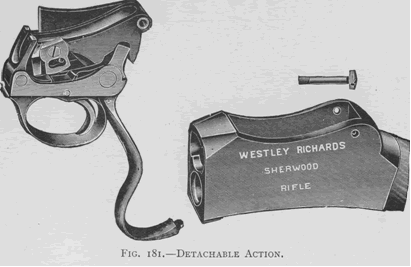
All the internal lock mechanism is removable by hand. A pin taken out by hand frees the clock-work, and it can then be readily detached for cleaning or repair, or any other purpose, and is as easily replaced. The Francotte system of removable action is well known, and possesses undoubted merit. The mechanism is mounted upon a separate frame, which is inserted within the shoe or breech. This arrangement somewhat adds to the weight. Further, the Sherwood possesses a detachable barrel.
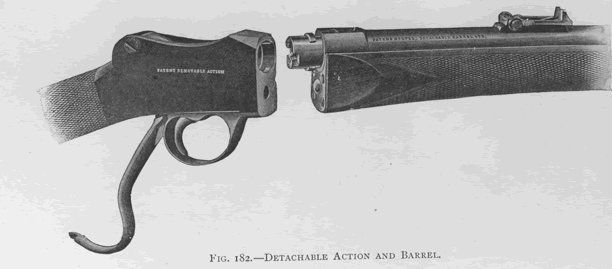
There are many systems of detachable barrels now in use, but I regard the Westley Richards system as the simplest and best. When, some years ago, this firm introduced this detachable barrel, which is attached by solid locking lugs, and secured in position by the forepart, I advanced the opinion that, while the locking lugs were secure, the fore-end attachment was of such a character that it might not absolutely insure freedom from lateral motion of the barrel within its breech.
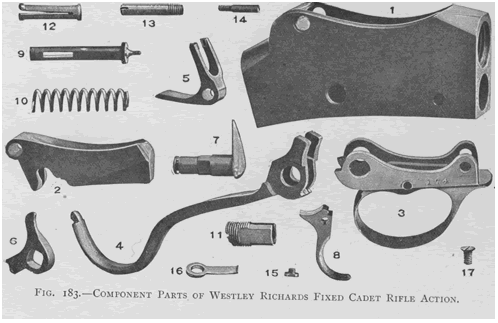
For sporting purposes, even if my anticipations were confirmed, and wear occurred at this point, I do not consider that it would affect shooting, but I am glad to note that, in their later forms of detachable barrel, Westley Richards have improved the fore-end attachment. This, after trial in high-power rifles, has proved to be very secure. With such an attachment the detachable barrel is practically as solid as the fixed barrel. It will be seen that the spring ball, which receives into a corresponding socket, prevents any lateral movement of the barrel. This ball is made of hard steel, and is therefore subject to little or no wear under friction. But wear, whether more or less, is taken up by the pressure of the spiral spring against the steel ball which forces it further forward, and so acts as a compensating fastening (Figs. 182 and 184).
SIGHTS FOR THE SHERWOOD RIFLE.
Too much importance cannot be attached to the question of the sighting of rifles, for the purpose of securing accurate results and as an aid to marksmanship. The sights fitted to the Sherwood rifle have reached a high degree of development upon lines which appeal to the thoughtful and intelligent marksman. They afford greater facilities for accurate aim under difficult weather conditions than are possessed by even the best European service weapons. For instance, we have the important qualification of making allowance for wind by a mechanical movement enabling the shooter to laterally adjust the sight in order to counteract the force of the wind upon the flight of the bullet.
All military authorities in the past alike have refused to acknowledge the necessity of a mechanical arrangement of any kind for making wind-gauge allowance. Their attitude may have been caused by the absence of reliable and durable systems, but it is, I consider, the more likely due to a desire not to confuse the ordinary soldier, whose intelligence may have been underrated or his education neglected. Marksmen, however, have invariably adopted with eagerness such appliances wherever the opportunity presented itself.
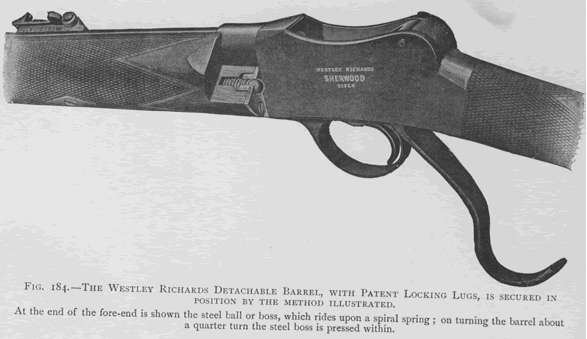
In another respect, equally essential to the proper training of the practical marksman, the sight possesses an improvement in the vertical movement or elevation of the sight slide. By this arrangement a nice adjustment may be calculated to the fraction of an inch, instead of to several inches, and in a rough-and-ready way as provided in other constructions of sights. The latter condition prevails with all European rifles, so that when the experienced marksman in long-range target shooting is desirous of adjusting his elevation to a more minute degree, he has to make use of a separate instrument called the " Vernier," carried in his pocket. This involves some little trouble and delay, but no marksman worthy of the name, in this country at all events, would think of entering into a competition without this vernier, and, indeed, without it no first-rate marksmanship is to be achieved.
Westley Richards have given considerable attention to this important branch of rifle-shooting, and for the first time have produced practical wind-gauge and vernier sights for attachment to their rifles which fulfil the military needs of strength and simplicity, and at the same time form great aids to marksmanship.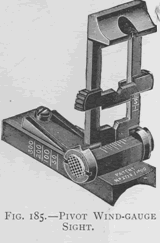
The mechanical principles of these sights are fully described in Chapter XI. It now only suffices to say that these improvements, so necessary for the military weapon, have wisely been adapted to the Sherwood miniature rifle. The Mark I Sherwood rifle is fitted with the ordinary tangent back-sight, but the leaf or tangent of this sight is capable of lateral movement across its bed. By pushing on the pivot the leaf is moved across for wind-gauge allowance. On closing down the leaf it automatically centres itself and returns to its original position, vide illustration above. This is extremely simple, and easily understood and manipulated.
Mark II Sherwood rifle is supplied with the wind-gauge and vernier elevating sight. The motion of the wind-gauge is the same as on the Mark I, but the pivot is moved across by a screw worked by the milled head, which gives a more accurate adjustment, such as is frequently needed when at the target,
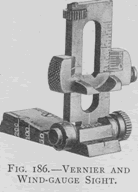
A further arrangement, securing accuracy of wind-gauge adjustment, is provided in this sight. The milled head is divided into
six notches, and, on turning the head, a spring " snicks" into a notch, each notch represents half-an-inch of lateral allowance upon the target, which is conveyed to the marksman by the sense of touch and through the ear, without troubling him to read the scale. This sight is a vernier in itself, dispensing with the separate vernier hitherto tarried in the pocket. By turning the head of the screw fitted at the side of he tangent leaf, an adjustment may be obtained of half-an-inch up and down. As a rule one inch represents the minimum allowance of elevation, and the scale may be divided into 1/150 th of an inch, a measurement equalling one inch for each 100 yards.
Some marksmen prefer a peep sight, and Westley Richards have also applied to this sight the pivot wind-gauge screw movement for lateral movement of the sight to correct the effect of the wind. This sight also has the micrometer arrangement of notches, as described above.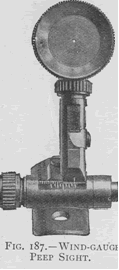
The National Rifle Association regulations for the Bisley meeting, 1906, concede the use of wind-gauge or laterally adjusting back-sights in both Miniature Rifle Competitions, Class A, and also in the Military Miniature Competitions, Class B. This is a step in advance.
This new regulation is not solely for the purpose of wind-gauge, it is more for the object of enabling the shooter to correct any error of sighting, either due to the construction of the rifle, to the operation of wear, or to faulty holding and aiming on the part of the marksman. This narrow and restricted use of this laterally moving sight is confined solely to the Bisley meeting ; in reality, the new regulation is a great stride, and opens up a field of promise for the cultivation of marksmanship amongst civilian clubs. In those clubs where shooting is conducted at longer ranges than 100 yards, advantage will be taken of the wind-gauge sight for use to correct the deviation of the bullet due to the wind, and it is to be hoped that, as a natural sequence, the National Rifle Association will extend the range for miniature rifle competitions, which the permission to use the wind-gauge sight renders all the more practicable.
Since the principle of the wind-gauge sight in its fullest and most practical aspect is admitted to be necessary upon the service rifle, rifle shots may be permitted to hope for this much-needed change in the regulations concerning miniature rifles.
N.R.A. REGULATIONS.
AMMUNITION FOR INDOOR SHOOTING.
With a bullet not exceeding 80 grs. in weight, observed velocity must not exceed 1200 feet per second over 20 yards. Energy equivalent to 222 foot-lb.
With a bullet exceeding 80 grs., not exceeding 100 grs. in weight, observed velocity must not exceed 100n feet per second over 20 yards. Energy equivalent to 256 foot-lb.
AMMUNITION FOR OUTDOOR SHOOTING.
Weight of bullet, maximum, 140 grs., observed velocity 1450 feet per second over 20 yards. Energy equivalent to 652 foot-lbs.
The conditions laid down by these official regulations approximately reproduce the ballistics of the Westley Richards Sherwood rifle.
It will, further, be noted that .32/40 cartridge is excluded from the miniature classification, as far as Bisley is concerned.
Mr. Greener's club rifle is made in a variety of patterns for target use and for sport. It has been used with satisfaction at small deer in India.

The Westley Richards Sherwood rifle is made in the following models —
MARK I.
The Sherwood club rifle, Mark I, with patent push-pivot wind-gauge back-sight. Detachable barrel and action in two qualities.
- As above, but with fixed action.
- As above, but with fixed action and ordinary tangent sight and detachable barrel.
MARK II.
The Sherwood club rifle, Mark II, with patent pivot wind- gauge back - sight and vernier elevator combined. Patent detachable barrel and action in two qualities.
- As above, but with fixed action.
- As above, but with fixed action and ordinary tangent sight and detachable barrel.
Each of these eight models may also be had in a variety of bores for well-known cartridges of established accuracy, such as the .22, the .297/.230, .250, and .300 rook- rifle cartridges ; as well also the .32/40, a most excellent cartridge. Weight of bullet, 185 grs., nickel base; muzzle velocity, 1440 feet per second.
The Sherwood is also made as a miniature match target rifle with attachable peep-sight collar fore-sight with three interchangeable discs of different sizes, and fixed spirit-level, chambered for the Sherwood or the .3240 cartridge. (Illustrated as on p. 338.)
The Westley Richards under-lever sliding-block rifle, chambered for the Sherwood cartridge and copper-capped expanding bullet for sport, with Axite powder.
With regard to accuracy, the Greener club rifle, the Sherwood, and the .32/40, have distinguished themselves at Bisley. The .32/40 is, however, a rifle that fairly may be considered outside the miniature rifle question.
Last year at Bisley the Greener and the Westley Richards Sherwood rifle both obtained highest possible scores at 100 yards in the Miniature Rifle Competition.
Richards rifle showed, out of seven consecutive shots, six consecutive in a space of by 113 inches.
The championship of the Leamington Rifle Club has been won for two years in succession by a Sherwood rifle. In 1903, the winner, Mr. Barr, out of 81 shots, giving a possible of 420 points, scored 403. On one occasion he made a possible of 35 at the distance of 350 yards, making a total of 103 at 100, 200, and 350 yards, out of a possible 105 ; and on two other occasions he dropped only one point at the 350 yards range. With such a high standard of accuracy at the longer ranges, which have been confirmed by the use of the weapon under sporting conditions, it is inconceivable that the Bisley authorities still refuse to provide competitions for miniature rifles beyond 100 yards.
Even the .22 long rifle cartridge shoots accurately to 200 yards, but has not the steady and reliable flight of the heavier projectiles recommended. The advantage of practising long-range shooting in
civilian clubs is that the youths are early trained to accustom their eyesight to aim at comparatively long ranges. The eyesight forming such an important factor in rifle shooting, the longer the range under reasonable practical conditions, the better.
More efficient marksmen would result from a course of shooting which had been carried on at from 200 to 500 yards than could be possible with competitions conducted at 100 yards range or thereabouts.
Introduced primarily for target purposes, the modern British miniature rifle is, nevertheless, a satisfactory sporting weapon within limits. The use of cordite and Axite powders, which permit a comparatively high velocity with remarkable accuracy, has made these simple-looking weapons of greater ballistic value than their prototypes of the past. They are, in a word, endowed with a degree of effectiveness which only larger and more powerful weapons could formerly lay claim to.
It is only to be expected that these improved qualities would appeal to sportsmen, who welcomed the advent of a rifle so light, neat, and handy, and yet so accurate and deadly. The deadliness or effective killing power is further increased by the use of new bullets, which, as it happens, have been introduced almost coincidently with this modern system of miniature rifle.
Elsewhere I have fully described the capped bullet system. The Sherwood cartridge has, during the last two years, carried a compound bullet, covered with nickel at the rear end, also one having a copper nose or front upon the capped system. The latter form shoots with extreme accuracy, and the expansive qualities have proved to be of a very high order, and are spoken well of by all who have used this system of bullet in actual sport.
Messrs. Westley Richards have, therefore, recently introduced a double-barrelled rifle, rifled and sighted for this sporting cartridge, which they call the " Double Sherwood." It weighs from 6 to 6½ lb., has perfect balance, and although recommended for deer shooting of the smaller kind, some very good shooting has been done with it at stags weighing as much as 231 lb., and even bigger species have been brought to bag by this little weapon.
Another pattern of miniature rifle for sporting purposes is the Minex, which has just been introduced by the firm of Westley Richards. It is constructed on similar lines to the Sherwood, but is .298-bore and is chambered for a bottle-necked cartridge instead of the straight taper Sherwood pattern. Another and important difference lies in the bullet adapted for this new cartridge. It is of the nickel-base lead pattern, but with the nose end surmounted by a hollow brass or copper cap similar to that employed in the Explora or Fauneta bullets. The Minex bullet is especially adapted for sporting purposes at deer, black buck, cheetul stag, and game, and possesses remarkable expanding qualities.
The following particulars convey some idea of this miniature express sporting rifle—
Weight of single Minex rifle, 6¼ to 6 lb. 10 oz.
Length of cartridge case, 1⅜ inches.
Weight of bullet, 140 grs.
As some people might be inclined to question the effectiveness of this weapon, I have given in Chapter XV a few reports received from Scotland, and I here give others, confirming these results, from British Columbia and India‑
" I may mention that with your Sherwood rifle I have shot black buck, and find your copper-capped bullets excellent. My wife has also shot two small cheetul stags with it." — LIEUTENANT‑
COLONEL D. M.
From BRITISH COLUMBIA—" . . . The caribou which I shot at 220 yards with the Sherwood is the largest bag secured with a rifle of such a bore."
With a party outward to NICOMEN, B.C.—" Our party has had at 'least passable sport along this game-frequented range, there's plenty to shoot, but as our time is so limited we are unable to follow far. The bag up to date is ten bears, two mountain sheep, big horns, and a number of deer. The Sherwood .300 accounted for four black bear, one big horn, and a number of smaller game."
The high standard of accuracy is, of course, a great factor of efficiency, enabling the sportsman, as it does, to place his shots in a vital spot with certainty ; but accuracy alone would not have enabled such a small-bore weapon, having a medium velocity, to bag game so successfully, were it not for the superior expansive qualities possessed by the copper-capped expanding bullet.
Frequently rifles, all too-powerful, are adopted for small deer, the high-power Mannlicher and Mauser rifles to wit. These weapons shoot bullets giving extreme penetration, owing to their high velocity and lack of expansion. The .256 Mannlicher, I know, is considered by some sportsmen unsuitable for chamois shooting, as it does not always kill, and it is probable that both for this sport and for ordinary deer-stalking at average ranges, a lower velocity weapon shooting a bullet of greater expansive quality would be more effective. It is, I consider, on account of these qualities that the Sherwood rifle has proved so successful.
There is another recommendation for these medium-power small-bore rifles, and that is, that in a limited stretch of country shooting can be conducted with greater safety. From time to time one hears from sportsmen who use a Mauser, a Mannlicher, or a .303-bore rifle for deer in thickly-populated India, that villagers are occasionally shot by users of these long-range weapons ; and these same weapons are also used for park deer at home.
Unless shots are taken against a fairly high background, the use of such weapons becomes dangerous, and, what is more, complaints are made that their bullets often pass clean through the object, allowing the beast to travel a considerable distance before dropping. This can only be expected from such conditions, namely, the high penetrative character of the bullet and the lightly-built animal against which it is used.
It does not, of course, take much to bring down deer of the smaller size, say of the fallow deer type and weight, and indeed the latter have been shot with a Mauser pistol ; although when properly hit with the solid and ordinary soft-nosed Mauser pistol bullet the animal is not immediately stopped. The Mauser bullet weighs 80 grs., and has a muzzle velocity of 1400 feet per second. Sir Bryan Leighton, in the year 1899, wrote to Messrs. Westley Richards that he had found the Mauser pistol when used with the all-range Mauser bullet to be effective, as the following particulars show‑
" He had previously condemned the Mauser soft-nosed bullet, as he found it only wounded the animals without stopping them. He fired a first shot at 60 yards, but as the deer went on he was at first under the impression that he had missed, so he fired another shot at 45 yards, after which the deer went on another 20 to 30 yards, and then fell. Finally, at a distance of i0 yards a shot was fired at the neck for experimental purposes. The shot which entered the shoulder was found to have penetrated the heart, making a hole through it about seven-eighths inch in diameter, and smashing a rib in two pieces with a hole of about the same size. The nickel then separated from the core. The shot in the neck passed right through to the other side and lodged just under the skin, with two small pieces of lead, weighing a few grains, detached. This bullet met the bone of the neck, shattered it, and mushroomed perfectly, having lost in the process only ten grains." Sir Bryan Leighton expressed himself as perfectly satisfied with the bullets, and considers the result gratifying.
But the all-range Mauser pistol bullet is far less effective than the capped bullet, as my own extended trials have shown.
The Sherwood bullet, it will be remembered, weighs 140 grs., having a muzzle velocity of 1450 feet per second ; the weight of the bullet is, therefore, nearly twice as much as that of the Mauser pistol bullet, which has proved satisfactory at fallow deer. From this interesting comparison we are better able to realize the effectiveness of the Sherwood, not only at the smaller, but even at the larger kind of deer.
It is certainly a fact that in India rifles of a power far beyond the necessity of sport are sometimes used. I have heard of high velocity .450 express rifles being used against black buck. The average weight of this beast is 85 lb., therefore conceive the effect of a .450 bullet possessing a striking energy of 4900 foot-lb. Doubtless this was not a weapon taken from choice ; the sportsman was probably after more dangerous game, and happened to come across the smaller animal. Such a lightly-built animal, however, would be better pursued with a Sherwood rifle, or one of a similar description, and for shooting this kind of game in India, Africa, New Zealand, South Africa and Canada, I do not think one could have a more reliable weapon when used with the copper-capped expanding bullet.
Messrs. Cogswell & Harrison are responsible for the introduction of the Certus rifle for miniature target shooting. It is constructed to shoot the .22 rim-fire short and long cartridge, and is a single-loader with a bolt-action. The shoe which carries the bolt and trigger mechanism is fixed to the barrel ; the stock and fore-end are of one piece, and the barrel and shoe, together with the bolt, can be readily detached from the stock by the removal of a pin, which enables the shooter to pack the rifle away in a small compass. Of simple construction and low price, we cannot apply too stringent a view to the workmanship. On the whole it is an efficient weapon, and as far as concerns low-priced small-bore miniature rifles, the Certus is probably one of the best of its class. There are several patterns of sighting. The standard pattern consists of an upright strip of metal, which works in two grooves fixed in a bed upon the barrel, and is lifted up and down for the different ranges, which are marked upon the front. The sight is made with a " V," and is held rigid by means of a pin.
This method of sighting equals anything that is applied to American and Continental weapons, but it falls below the best British efforts in this connection.
Among the earlier types of American miniature rifles introduced into this country for target purposes, was the single rifle known as the Ballard. This had an under-lever falling block-action, the block being actuated by the under lever. The lock mechanism was cocked separately by hand. It was constructed to shoot either the .22 rim-fire cartridge or a .22 central-fire cartridge, known as the .22 Winchester, which fired 14 grs. of powder and 45 grs. bullet, shooting with considerable accuracy up to 150 and even 200 yards.
Almost concurrently with this weapon, both the Winchester single-shot rifle and the Remington single-shot rifle, .22-bore, were introduced here. They were regulated either for the .22 short rim-fire cartridge or for the long .22 central-fire cartridge mentioned. These constitute the American single-shot miniature rifles in vogue in this country twenty years ago.
About that time the Colt and Winchester Companies placed before the British sportsman their repeating rifles for the .32, .38, and .44 calibre cartridges. The .32 calibre shooting 20 grs. of powder and 100 grs. bullet in either pattern weapon shot with considerable accuracy up to 200 yards and more.
Some little time subsequent to this the Marlin Company introduced rifles shooting this cartridge as well as other sizes.
Amongst others was a repeating rifle shooting a .25/36 cartridge. This was a bottle-necked central-fire cartridge, the bullet of .250 calibre, shooting 23 grs. smokeless powder and 117 grs. bullet, an exceedingly accurate cartridge up to S00 yards. This firm also introduced the .300-bore cartridge, with a long bottleneck, known as the .33/.30 smokeless ; charge 29 grs. smokeless powder, 160 grs. bullet. This was quickly followed by a .320 calibre cartridge known as .32/40, also accurate to 400 or 500 yards.
Magazine rifles at the best are not ideal target weapons, the cartridges occasionally get damaged in passing from the magazine into the chamber ; besides this, the balance of the rifle is disturbed at each shot, which is not conducive to the highest accuracy.
Amongst modern American rifles enjoying considerable popularity in this country is the Stevens .25 rim-fire rifle. This cartridge is accurate enough to 200 yards ; its charge is 11 grs. of black powder and 65 grs. bullet. This weapon is constructed on the sliding-block principle, having an under lever to work the block, as well as to effect the cocking of the arm. It has a detachable barrel, although on a crude system, and can be packed in a small compass. Owing to its low price and portability, and shooting cheap ammunition, this weapon undoubtedly assisted in popularizing miniature target shooting.
Another pattern of rifle by the same maker has a longer barrel, and weighs from 2 to 3 lb. heavier. This is known as the " Ideal" rifle.
During the last twenty years the Remington Arms Company
have sold a large number of their single-shot rifles in this country. They were bored for the .22 rim-fire short and long cartridges.
There are now supplied amongst modern American rifles the Stevens, Winchester, Savage, Marlin and others, as well as rifles of Belgian manufacture, all shooting the .22 rim-fire cartridge for gallery or indoor shooting. Such weapons have long been in use at the shooting-galleries of country fairs, and if their capabilities are to form the standard, the travelling caravan may be regarded as the pioneer of civilian rifle-shooting.
Weight of Stevens' Favourite, .22 short 4½ lbs.
,, Ideal, English model, .22 short 5¾ lbs.
,, American match, .22 short, 7 lbs.
,, Winchester single-shot, .22 short, from ... 4¼ lbs.
,, Savage Target Rifle, .22 short, from ... 4¾ lbs.
The War office has produced its own model of miniature rifle, of which I understand the bolt, fore-sight protector and back-sight are all of Government design. The other items have been selected from six competing models which were submitted by gun manufacturers, whose sole reward, I am informed, lies in the honour of contributing ideas which are regarded as unpatentable combinations. Had these gunmakers been responsible for the whole effort, they would not have had much to boast about.
This miniature rifle is very much on the lines of the American small-bore rifles, already alluded to and so familiar here during many years, having the same pitch of rifling, and shooting an American cartridge of .22-bore.
This Government miniature rifle is on the bolt principle.
Length of barrel, 24 inches.
Length over all, 41½ inches.
Weight, 5 lb. 5 oz.
Bore, .22 for long cartridge, rim-fire.
Charge of powder, 5 grs. semi-smokeless.
Weight of bullet, 40 grs.
Length of cartridge, 31/32nds., of an inch.
Length of case, 39/64ths., of an inch.
Weight of cartridge, 55 grs.
It is sighted to 200 yards, which is an extreme range for the long '22 cartridge, and is principally intended for indoor use at 25 yards, and also for shooting up to 100 yards, in this respect confirming the mistaken policy adopted by the National Rifle Association with regard to the range for miniature competitions.
The best feature of the weapon is the back-sight. It is of the flap-up pattern similar to the new service sight, and has a wind-gauge bar, though of an antiquated pattern. The Westley Richards sight of this pattern is far superior and of more mechanical construction.
This new Government weapon has not yet been subjected to a thorough test, but it may prove successful within its limit. If produced cheaply, it may have a demand, but the civilian who takes rifle-shooting seriously is more likely to prefer one of the superior rifles of large calibre and longer range which I have described.
In a small but very instructive pamphlet, entitled The Art of Shooting with the Rifle, published in 1888 by the late Sir Henry Halford—who gave a life-long devotion to the art of rifle-shooting —we read at the conclusion of his work—
"I shall be well repaid for my trouble if I can induce one Englishman to become a rifleman. Believe me, the use of the rifle is a sport in itself. More than that—and far more-- the rifle of the present day is the long-bow of the middle ages. If the youth of England could use the rifle, the strength and power of the United Kingdom would be invincible."
When this experienced rifle-shot uttered these words, he was only foreshadowing what we all hope may be the outcome of the civilian rifle movement.
As a long-range shooter we may be sure that he would have had little or no sympathy with the feeble methods of teaching rifle-shooting now in vogue. The long-range rifle doubtless is, as he says, the equivalent of the long-bow of the middle ages, but many of us would have expressed surprise if we had learnt that our ancestors taught their youth the use of the long-bow by means of a catapult, which would be no more ineffectual for their purpose
than the air-gun and the .22-bore are for our modern requirements. Even with the long-bow good practice was made at 300 to 400 yards, and it strikes one as somewhat of a retrograde movement for the youth of England in these times to have their tuition confined to short-range shooting.
As stated in the retrospective chapter, the laws enacted in the reign of King Henry VIII. demanded that every able-bodied man should be trained in the use of the long-bow. But these laws further insisted that shooting should not be conducted at shorter ranges than 220 yards under a penalty. In the statutes of the reign quoted concerning the practice of shooting, there is a provision forbidding shooting at a standing mark, except for a rover, by which is meant snap-shooting, when a less range was permitted, but even in this case a change of target was compulsory at each shot.
Notwithstanding the great progress made in the construction and capacity of fire-arms, by which their use has become effective to a mile or so — more than trebling the effectiveness of the longbow — nevertheless, modern authority endorses the policy that under the requirements of an increased range, three times greater than that of the long-bow, marksmanship is to be taught and acquired by practice at one hundred yards out of doors, and but a stride or two away within doors. And this to those individuals who will some day, perhaps, be called upon to handle the long- range modern rifle, and expected to be proficient in its use at a mile or more. Our ancestors well knew that proficiency in marksmanship, even though the range of the firing apparatus were limited to 400 yards, could not be taught or acquired at a less normal range than 220 yards.
A word should be said about the sighting of the American rifles as compared with the sighting of English rifles.
It is well known that in America rifles are made throughout by machinery ; there is no handwork on them, and in many instances builders of rifles do not make their own sights. They obtain them from a company which confines its attention to making all kinds of sights, and turns out both back- and fore-sights by the thousand. The requisite slots are made in the barrels of the rifles by the rifle-makers, and in the assembling of the machined parts after they have been blacked and hardened, the sights are knocked in.
The rifles are constructed to shoot straight, but the fine adjustment of the different distances is left to the shooter to arrange, and we have always considered this a great drawback in American rifles. Instead of following their rough-and-ready method of sighting, makers in this country regard the sighting as being second to no other process in the construction of the weapon, and each target rifle made by a trustworthy firm is carefully graduated and sighted and shot at individual ranges which are marked on the sight, thus saving the shooter considerable time and expense, besides giving him a guarantee that the rifle has been tested and shot for accuracy by an expert.
In the matter of sights the English gunmaker is undoubtedly far ahead of his American competitor.
We have seen a number of wind-gauge sights patented and made in America, but we have never yet seen one that we have considered worthy to be put on a rifle with any pretensions to fine workmanship. There are perhaps two sights in America that are deserving of praise, those are the two sights extensively made by the Lyman Company, generally known as the Lyman combination rear-sight, fitted on the butt of the rifle, and the Beech combination fore-sight. These two peep sights in conjunction are undoubtedly a boon to target shooters, and have considerably increased the possibilities of scoring. But, to be quite fair, we may point out that both the principles of these sights were in vogue in England years before America dreamed of making rifles or sights.
This subject would not be complete without reference to the modern air-gun or rifle. For the want of better practice out of doors with a rifle of effective range, a large number of our citizens, to whom the late Lord Salisbury's appeal was especially directed, have enthusiastically taken up air-rifle shooting within doors. It may not be much, but it is something towards the increase in the interest all good citizens desire to have taken in this question, and it is difficult to suggest a better solution of the problem which has (I) to adapt its needs to smaller rooms than are suitable for longer range work ; (2) to deal with a class of people whose occupations prevent them from daytime practice ; and (3), perhaps the most important factor of all, viz, to provide weapons and ammunition that will permit this recreation to be enjoyed at an infinitesimal cost.
It is, at all events, a nursery ground for the elementary training in marksmanship, which may inculcate an interest and a larger and more serious attention to the question of practical outdoor rifle shooting. Many of the air-gunners practising in small rooms to-day may become the practised and proficient rifle shots of to-morrow. This question has, therefore, given a great stimulus to the makers of air-guns. A few years ago the air-gun was but a toy, whose use was confined, for the most part, to the genus boy. Upon the formation of air-gun clubs, greater accuracy was found to be necessary. The ordinary smooth bore represented by the then existent air-gun, of which the Gem pattern was one of the chief exemplars, was not accurate and reliable. Thus an opening was provided for the production of an improved weapon, and the opportunity was seized by several gunmakers to introduce new weapons of improved utility, and bored and rifled accurately in order to make shooting more interesting, and therefore more instructive.
Perhaps the best of these air-rifles is that manufactured by the Birmingham Small Arms Company. The length of the barrel is 19½ inches, and it does not break down in order to load, as in the old Gem pattern, but is fixed. The weapon is cocked by a separate lever, which is situated underneath the barrel. As this lever is pulled down, the spring operating the piston is compressed, and the arm is cocked. The pellet or slug is inserted in the following manner : A taper plug passes through the barrel at its junction with the air-piston chamber. This plug is turned round by a short external lever on the left side of the weapon, until it is clear of the pellet chamber. After the pellet is inserted, the plug is turned back again, carrying the pellet with it.
The makers claim that the plug and fixed barrel have great advantages over the break-down system. There is this disadvantage however, as constructed, the operation of loading is slow, two more operations are necessitated by this separate plug movement than in the break-down system. The operations are as follows-
- Opening the lever placed underneath the barrel.
- Closing the lever placed underneath the barrel.
- Turning the external lever and plug in order to expose the loading aperture.
- Placing the pellet within the aperture for entry within the chamber.
- Turning back the lever to close the aperture.
Messrs. Westley Richards have shown me an improvement upon this system which obviates the objection of slow loading in this B.S.A. rifle. It consists of an attachment between the arm of the cocking lever and the external plug, which we have seen has to be moved separately and independently. By this attachment the depression of the lever causes at the same time the plug to turn, and thus in two movements is done what the original arrangement required four to accomplish. This system is very cheap, and has the additional advantage that for an insignificant price all existing rifles of the old type can be fitted with this attachment, which can be easily fixed by the owner upon his air- rifle. Further, the rifle may be used, if desired, without this attachment. The saving of mechanical operations in manipulating these air-rifles will, however, I think, appeal to the majority, and if this be so, future supplies may be manufactured with this external loading system provided as a fixture on each weapon. This will enable the manufacturer to abolish the upright extension of the loading plug, which is an objectionable and unsightly feature of the present air-rifle.
The barrel of this rifle is bored .177 inch in diameter, and is rifled with shallow poly-groove rifling, which is found satisfactory for the accurate driving of the leaden pellets.
The weight of rifle is about 7 lb. and the point of balance is 6 ½ inches forward of the trigger. The stock is supplied in three lengths, 13¼, 13¾, or 14¼ inches from the trigger to the centre of the butt. The back-sight gives a maximum range of elevation of 1/10th., of an
inch, is 11½ inches forward of the trigger, and compares favourably with the .303 rifle in this important point.
The sights are of a varied design. Some people advocate laying down a definite pattern of open sight for use by the affiliated air‑
rifle clubs. This is to be deprecated, and marksmanship is much more likely to be learnt by individual experiments with a range of sights than by a rigid adherence to one pattern, which cannot possibly suit all individual needs. The rifle is interchangeable, so that worn parts can be readily renewed.
The best slugs or pellets for these weapons are manufactured by Kynoch, Ltd. There are two varieties, the " Match," weighing 10 grs., and the " Witton," weighing 8 grs. The "Match " is considered to be the most successful design.
The " Britannia " air-gun, of same calibre, is another pattern which finds favour. It is an improved form of the Gem type, with break-down barrel, and is supplied by all gunmakers.
Although it can scarcely be said that marksmanship can properly be taught within doors, there is no doubt that many points of elementary instruction may be there acquired by the beginner. The Morris tube has helped in this direction, but its ranges and general equipment are expensive. Now that efficient air-guns built upon practical lines have been introduced, I believe that they will be more and more used in the Volunteer and regular corps, in place of the Morris tube. They have this advantage, that they are suitable for the particular elementary kind of training referred to, such as aligning the rifle, bringing up the weapon to the shoulder, and snapping off within a given time ; and so enable the shooter and instructor to quickly ascertain the results of errors.
Messrs. Westley Richards & Co. have shown me an air- gun with fixed barrel, of a type already described, attached to the breech action and stock of a British Government service rifle. This arrangement retains the service weight of the rifle, its length of barrel, the external shape, form, and dimensions of stock, and the same trigger and guard and magazine, so that the handling of this combination air-rifle is the same as the service rifle, which is of great importance in the training of recruits.
One other matter, which is perhaps of greater value, is that it enables the same form of back-sight and fore-sight to be employed as on the service rifle.
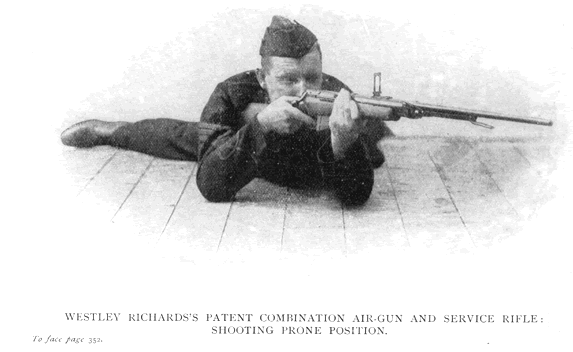
These sights having the same radius, give the same angle in sighting as the service rifle, and are, therefore, of the same value at any range ; a recruit having learned to snap-shoot with this weapon and to estimate the exact value of any error in sighting at a distance of seven yards indoors, has nothing to unlearn when he takes the same weight of rifle with its other conditions for outdoor longer ranges. And so equipped with these rudimentary instructions, he can now proceed to the serious business of learning to shoot.
Since writing the above it is gratifying to note that the Army Council has given official recognition to the Society of Miniature Rifle Clubs, and agrees that the Society shall have equal powers and be accorded privileges similar to those now enjoyed by the National Rifle Association.
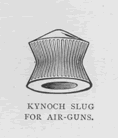
Another informative piece on Miniature Rifles was written by H. Marks in 1906.
He was instrumental amongst those promoting the opening of rifle clubs around the country,
and wrote widely on the subject, including his book "Citizen Rifleman" published the same year as this article.
This is in the form of a text-searchable flip-page document that may take a few moments to load.
Several rifle images link to their respective information pages